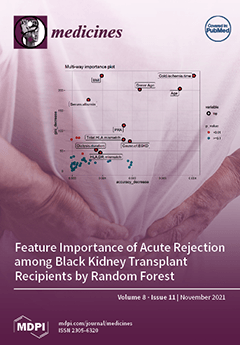Background: Transfusion-transmissible infections are well-known global health challenges. The present study is proposed to investigate the seropositivity of anti-HIV1/2, anti-HCV, HBsAg, and anti-
T.pallidum among volunteer blood donors of Kosti Obstetrics and Gynecology Hospital. Methods: Our study was conducted in a cross-sectional retrospective manner. The data of donors who attended Kosti Obstetrics and Gynecology Hospital throughout 2016 to 2018 were reviewed and retrieved manually from blood bank records. Results: Out of 8139 donors, 22.52% were seropositive for serological markers of TTIs and 1.67% were seropositive for at least two serological markers of TTIs. The overall seropositivity rate of anti-HIV1/2, HBsAg, anti-HCV, and anti-
T.pallidum was 1.77%, 6.07%, 1.14%, and 11.87%, respectively (
p < 0.000). Anti-
T.pallidum was the most frequently detected (
p < 0.05) marker across all study variables. TTIs seroprevalence was significantly (
p < 0.05) varied according to the age, residence, occupations, and blood groups. Notably, there was a rising trend in the rate of anti-HIV1/2 and seropositivity for more than one marker with age (
p < 0.000). Regionally, rural area residents had a higher rate of anti-HIV1/2 (2.20%), HBsAg (6.31%), anti-HCV (1.42%), anti-
T.pallidum (18.38%), and multiple markers seropositivity (2.28%) compared to urban areas. Between occupations, the highest rate of anti-HIV1/2 (
p = 0.483), HBsAg (
p = 0.003), anti-HCV (
p = 0.408), anti-
T.pallidum (
p < 0.000), and multiple markers seropositivity (
p < 0.000) were detected in farmers. Regarding the screening, we also found that the frequency of anti-
T.pallidum was significantly (
p = 0.003) higher in donors who carry the AB+ve blood group, whereas anti-HCV (1.83%) was more frequent in donors carry O−ve blood group (
p = 0.255). As seen, anti-
T.pallidum+HBsAg was the most frequently (1.22%) co-occurring markers. In contrast, anti-
T.pallidum+anti-HIV1/2+HBsAg was the lowest frequency one (
p < 0.000). Conclusions: The study showed an alarming rate of TTIs, which suggests the requirement for comprehensive surveillance and health education programs.
Full article




